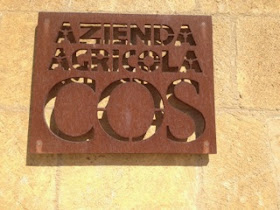"Robert Parker has made things very difficult for us," said the publicist. Parker had given a 96 to one of their reds - Maldafrica, a blend of (you guessed it) cabernet sauvignon and merlot, with some native Sicilian frappato tossed in - although it's neither a characteristic blend for COS nor one of their best. However, Parker's review caused a world-wide run on all of them.
It's a difficulty most wine producers would welcome, but not the Azienda Agricola COS. The acronym was formed by the first initials of the three Sicilians, Giambattista (Titta) Cilia, Giusto (Justo) Occhipinti and Cirino (Rino) Strano. They were friends who came late but enthusiastically to the trade. In 1980 they became the youngest winemakers in Italy by purchasing Joseph Cilia’s old family winery in the town of Bastonaca. Their first harvest produced only 1470 bottles, but got attention beyond the region of Cerasuolo di Vittoria in southeast Sicily.
COS is farmed bio-dynamically, a radical step there and a measure of commitment. They conform to Rudolf Steiner's prescriptions for maintaining a self-sufficient agricultural enterprise, and presumably to the lunar requirements for planting and all that implies. Downspouts on the property lead into a single reservoir used for irrigation when needed; there are enough solar panels to meet the winery's appetite for power. Chopin is piped into the cellar, not so much for the music as for the vibrations inherent in piano sonatas.
Intrigued by ancient cellar practices, they decided to use big clay jars called amphoras instead of steel tanks or barrels for fermentation and aging. Modeled on ancient vessels, the new amphoras were shipped from Spain in 2000, and sunk in gravel where they remain.The practice raised eyebrows all over Italy, where winemaking innovations are often reluctantly received, adding to what was already a reputation for innovation and risk.
 |
| Justo |
It's a magical spot overall, but don't drop in. First make an appointment, then chance your way through through confusing rural byways of which there are thousands. Getting lost can be a pleasure until you realize you might miss lunch. We finally found the place in time to dine al fresco with the crew during their break in the picking of the last of the pithos bianco, the local Grecanico grape.
I later tasted through all the wines, the overall impression being one of intensity, a unique freshness of flavor, and low alcohol. I attributed this to the absence of wood in most of the wines, though I can't explain the low octane and COS can't either. ("Cool air comes down from the mountains," said the publicist, Joanna, "and cool breezes from the sea.") Usually hot countries like Sicily - think of the Rhone valley, or Napa - push the upper limits of alcohol, yet COS's hover for the most part between 12 and 13 percent.
Some of the reds do get a bit of time in barrel - the 100 percent Nero d'Avola, and the Bordeaux blend - but even in the amphora-bred ones there is detectable tannin picked up from the grape skins. The vineyard sits on thin clay overlying lots of limestone, hence the strong mineral component in the wines. One question is whether or not these wines age well. The frappato doesn't evince the guts for a long haul, though it's delicious when young and a good addition to the nero.
Sicily shares the geology of both Sicily and north Africa, which is close enough for you to see the occasional dust storm blowing out of the Sahara. The name, Maldafrica, for the Bordeaux blend Parker swooned over, was chosen on a whim, and is indeed impressive. More characteristic, and interesting, is that Sicilian classic, Contrada, all Nero d'Avola in French oak for two years, with big body and a long earthy finish.
The 2012 Cerasuolo di Vittoria Classico is 60 percent Nero d'Avola and 40 frappato and, yes, has lots of black cherry on the nose and real presence. The whites, too, are memorable, with deep golden hues that have nothing to do with oxidation and much to do with exotic grapes of a place where wine-making goes back almost to the beginning.
We slept in the manor house, in a bed watched over by a painting of sporting putti. That was fortunate because I was awakened at 2 a.m. by gunshots, not mafiosi but a neighbor unloading - I think - on a rabbit.
I stepped out onto the balcony. Moonlight hung dimly in the eastern sky, and everywhere was the smell of arid earth and things growing: dirt, smoke, precious water, night-blooming trees and, as in the wine itself, the fragrant mystery of an ancient, unknowable land.
I stepped out onto the balcony. Moonlight hung dimly in the eastern sky, and everywhere was the smell of arid earth and things growing: dirt, smoke, precious water, night-blooming trees and, as in the wine itself, the fragrant mystery of an ancient, unknowable land.
Photo by Penny Conaway









No comments:
Post a Comment